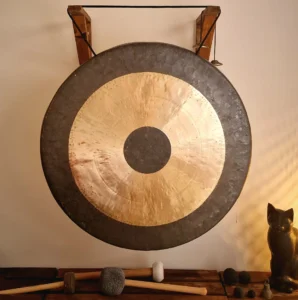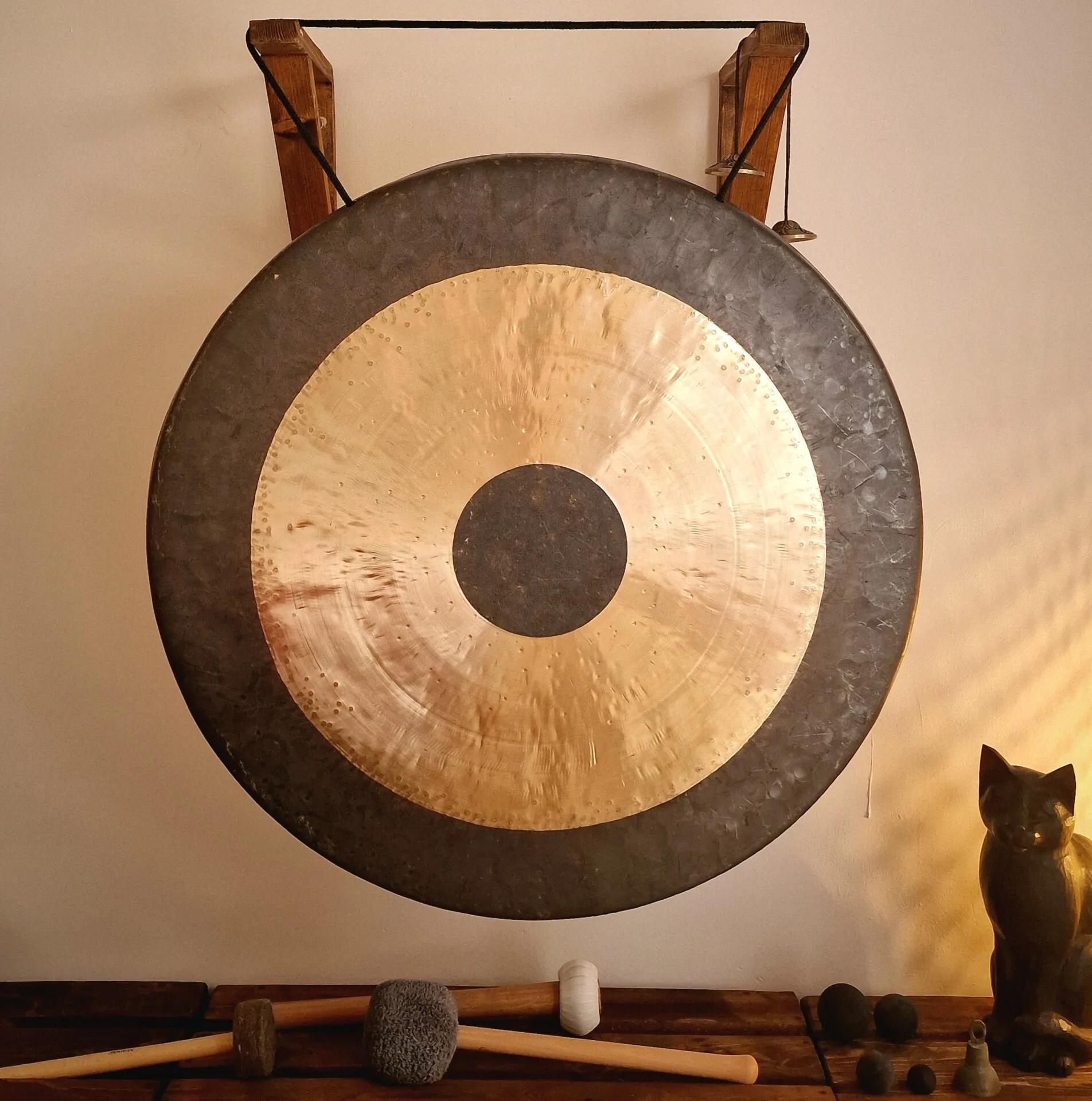
Choosing a Gong
Selecting a gong is a responsible task since it is a powerful and not inexpensive instrument. I chose a Tam Tam Gong, which has since become a true friend. Listening to its sounds, feeling its vibrations, and experiencing its unique energy and power is like entering another world. The sound of the Tam Tam Gong is deep and long-lasting, with a broad spectrum of overtones and undertones. When struck, it produces a powerful, gradually swelling, and receding tone. The gong can be played with different mallets, producing various sound nuances. This allows for both very low and very high sounds, reminiscent of whale songs.
Uses of the Tam Tam Gong
Sound Therapy and Healing
In sound therapy and healing, the Tam Tam Gong is used for its deep, resonant sound, which has a harmonizing and relaxing effect on the body, mind, and soul. The vibrations of the gong can help dissolve energetic blockages, reduce stress, and promote deep states of relaxation. Sound therapists often use the Tam Tam Gong in sound baths and individual therapy sessions to support holistic healing and regeneration. It’s important to note that the gong acts as a mirror of our soul; its sounds are perceived differently by each person. When we open up, thoughts, feelings, and sensations can be triggered. Images may appear in our mind’s eye, helping us identify and resolve blockages. Afterwards, we feel free, light, and happy! Using the gong in sound therapy requires great sensitivity and responsibility.
Meditation and Yoga
In meditation and yoga, the deep, long-lasting sound of the Tam Tam Gong promotes deep relaxation and meditative states by calming the mind and helping to focus inward. Its resonant tone supports the release of stress and the harmonization of inner energy.
Rituals and Ceremonies
The Tam Tam Gong is used in rituals and ceremonies to create a sacred atmosphere and enhance spiritual energies. Its deep, penetrating sound energetically cleanses the space, promotes meditation, and helps establish a deeper spiritual connection.
Orchestral Music
In orchestral settings, the Tam Tam Gong produces dramatic and impressive effects with its deep, resonant sound, enhancing tension arcs and highlighting emotional peaks. Its long-lasting, gradually swelling, and receding tone adds a mystical and majestic atmosphere to musical passages.
Film Music and Soundtracks
In film music and soundtracks, the deep, booming sound of the Tam Tam Gong enhances the emotional intensity and tension of scenes, creating a mystical or ominous atmosphere and providing impressive acoustic highlights. Its long-lasting resonance contributes to dramatic underscoring and atmospheric depth.
Visual Arts
In visual arts, the Tam Tam Gong is used as a sound element in installations and performances to create interactive and immersive experiences. Its deep, resonant sound enriches artistic expression and can have a strong impact both visually and audibly by connecting different sensory experiences.
Education and Music Instruction
In music education and pedagogy, the Tam Tam Gong is used to introduce students to sound diversity and rhythmic complexity. Its deep, layered timbre allows teachers to demonstrate various playing techniques and acoustic properties of percussion instruments, fostering an understanding of musical expression possibilities.
History of Gongs
The Tam Tam Gong originates from Chinese culture and has been an important traditional percussion instrument there for centuries. However, the gong also holds significant value in other Asian cultures, such as Vietnamese and Indonesian music. Similar to church bells, the gong was a traditional calling instrument. Whenever there was an announcement to make, the gong was struck, and villagers gathered to hear the news. Today, the Tam Tam Gong is used in both Western orchestras and traditional ceremonies, meditations, and sound therapies.
Manufacture of the Tam Tam Gong
The Tam Tam Gong is made from a special alloy primarily consisting of bronze, copper, and tin. This alloy is heated and cast into a flat, round shape. The blank is then worked and smoothed to obtain an even surface. Next, it is hand-hammered and tuned to develop the gong’s characteristic sound properties. Finally, the Tam Tam Gong is polished to give it its shiny appearance.





